 |
| Funchal Morning Sun by Edward Poynter. |
Last week, Carolyn and I caught a plane from Bristol to fly south to the beautiful Portuguese island or more precisely, archipelago of Madeira, out in the Atlantic, just off the North African coast of Morocco, to enjoy a bit of warmer weather after enduring quite a cold last few months here in the UK and in need of a bit of sunshine.
Madeira, originally uninhabited, was claimed by Portuguese sailors in the service of Prince Henry the Navigator in 1419 and settled after 1420. It is a popular year-round resort, particularly for fellow Portuguese, but also British (148,000 visits in 2021), and Germans (113,000).
It is by far the most populous and densely populated Portuguese island. The region is noted for its Madeira wine, flora, and fauna, with its pre-historic laurel forest, classified as a UNESCO World Heritage Site. The main harbour in Funchal has long been the leading Portuguese port in cruise liner dockings, and is an important stopover for Atlantic passenger cruises between Europe, the Caribbean and North Africa.
This would be our first visit to Madeira and we were really looking foreword to visiting it as well as enjoying the warmer climate it offered, with an opportunity to explore the history, enjoy the food and of course Madeira wine and take in a bit of walking for which the island has some amazing country walks that follow the famous mini-canals, levadas, that irrigate the dry southern half of the island with the copious rainfall from the northern half.
We had booked ourselves an apartment in the island capital, Funchal, which also had an underground carpark for our hire car which we collected on our arrival at the air port before starting our drive into the city.
As with all these kind of adventures you can plan and prepare as much as you like but it is not until you get there that you can really understand the opportunities and the challenges that present, and Madeira proved to be right up there with the best in terms of both.
 |
| The engines are throttled back as we begin our descent to Madeira airport |
Madeira is a volcanic pinnacle of an island with a spine of mountains forming the summit of this large rock sat in the North Atlantic just off North Africa, with what little flat ground there is at an absolute premium.
 |
| As we break through the cloud base I get my first view of the island |
This was only too obvious when I got my first view of the airport precariously perched on one of these rare flat coastal ledges and in the last twenty years has seen a massive construction programme that has seen the rerouting of all the principle island roads through a series of rather long and deeply dug road tunnels, some two or three kilometres in length that have been driven into the volcanic pumice and in the case of our drive from the airport into Funchal reduced a journey from over two hours before 2000, to the fifteen to twenty minutes it takes today.
However much of the charm of Madeira is the timeless aspects of its scenery and architecture, with the view depicted in the header of a morning sun over Funchal by the nineteenth century painter Edward Poynter easily visualised in modern day Funchal, but of course combined with the twenty-first century requirements of getting cars to be able to drive down narrow streets designed for horses and buggies, and on streets with an incline that demands perfect clutch control, without burning the thing out, often to avoid cars simply parked on any flat space available that doesn't have something in the way preventing such abandonment.
Simply put, getting around in Madeira can be one of the challenges, but I would argue that the opportunity to explore an amazing paradise, populated by the most lovely and friendly people, with views, historic architecture, cuisine and the history of the place, combined with a glorious climate would explain that our nine days was not enough and we have put a date in the diary for a return visit in the not too distant future.
As mentioned Madeira was discovered by the Portuguese and in 1418, two captains, João Gonçalves Zarco and Tristão Vaz Teixeira exploring under service of Prince Henry the Navigator, were driven off course by a storm to an island they named Porto Santo (English: holy harbour) in gratitude for divine deliverance from a shipwreck.
The following year, Zarco and Vaz organised an expedition with Bartolomeu Perestrello. The trio travelled to the island and claimed it on behalf of the Portuguese Crown and established a settlement. The new settlers observed "a heavy black cloud suspended to the southwest" and upon investigation discovered the larger island they called Madeira.
The following year, Zarco and Vaz organised an expedition with Bartolomeu Perestrello. The trio travelled to the island and claimed it on behalf of the Portuguese Crown and established a settlement. The new settlers observed "a heavy black cloud suspended to the southwest" and upon investigation discovered the larger island they called Madeira.
 |
| We found some great restaurants during our stay, and the fish and seafood is another level in Madeira |
The British first amicably occupied the island in 1801 whereafter Colonel William Henry Clinton became governor. A detachment of the 85th Regiment of Foot under Lieutenant-colonel James Willoughby Gordon garrisoned the island.
After the Peace of Amiens, British troops withdrew in 1802, only to reoccupy Madeira in 1807 until the end of the Peninsular War in 1814.
In 1856, British troops recovering from cholera, and widows and orphans of soldiers fallen in the Crimean War, were stationed in Funchal, Madeira.
During the Great War on 3 December 1916, a German U-boat, SM U-38, captained by Max Valentiner, entered Funchal harbour on Madeira and sank three ships, bringing the war to Portugal by extension. The ships sunk were:
During the Great War on 3 December 1916, a German U-boat, SM U-38, captained by Max Valentiner, entered Funchal harbour on Madeira and sank three ships, bringing the war to Portugal by extension. The ships sunk were:
- CS Dacia (1,684 tonnes or 1,856 short tons), a British cable-laying vessel. Dacia had previously undertaken war work off the coast of Casablanca and Dakar. It was in the process of diverting the German South American cable into Brest, France.
- SS Kanguroo (2,262 tonnes or 2,493 short tons), a French specialized "heavy-lift" transport.
- Surprise (620 tonnes or 680 short tons), a French gunboat. Her commander and 34 crewmen (including 7 Portuguese) were killed.
 |
| View of Funchal circa 1840 |
After attacking the ships, U-38 bombarded Funchal for two hours from a range of about 3 kilometres (2 miles). Batteries on Madeira returned fire and eventually forced U-38 to withdraw.
On 12 December 1917, two German U-boats, SM U-156 and SM U-157 (captained by Max Valentiner), again bombarded Funchal. This time the attack lasted around 30 minutes. The U-boats fired 40 120 and 150 mm (4.7 and 5.9 in) shells. There were three fatalities and 17 wounded; a number of houses and Santa Clara church were hit.
 |
| View of Funchal circa 2024 |
 |
| Sunset over Funchal, seen from the terrace of our apartment. |
As regular readers of the blog will know, I am a keen proponent of the joys of incorporating a love of history with a love of travel and a love of natural history and found opportunity to enjoy this alchemy in spades during our stay.
The tombstones offered a fascinating insight to the history of Madeira as a major, trade, travel and naval revictualling port, with the numerous inscriptions to British merchants, the wealthier classes from Georgian and Victorian Britain that relocated to Madeira for its obvious benefits in climate and others whose memorials prompted further research.
The US Consul to Madeira, George True, only warranted a short two line notice of his death at the age of 30, in the copy of the New York Times I found recording his passing, but I was intrigued to see the memorial to him was erected by the crew and officers of the U.S.S. St Louis, especially given the date, the 22nd February 1864, in the final year of the American Civil War
 |
A painting depicting the naval battle between the USS Kearsarge and the CSS Alabama, known as the Battle of Cherbourg 1864 - Xanthus Russell Smith |
The St. Louis was a sloop of war launched in 1828, with a compliment of 125 officers and men and armed with twenty 24-pounder smooth bore guns.
In 1862 she was rearmed with four 8-inch shell guns, twelve 32-pounder guns, two 20-pounder Parrott Rifles and one 12-pounder smoothbore before sailing to Cadiz, Spain, to join the Federal Squadron patrolling the Atlantic off the African coast between the Canaries and Azores in search of Confederate commerce raiders.
 |
| The USS St Louis in 1854 |
With comparisons with another famous hunt for a commerce raider, the German Graf Spee at loose in the Indian Ocean and South Atlantic in 1939, the hunt for the British built, Screw Sloop of War, CSS Alabama had similar drama, when after five successful commerce raiding expeditions in the Atlantic the Alabama was forced, after 22 months at sea and the destruction of 65 US merchant ships, to seek refitting and repairs to her boilers in the neutral French port of Cherbourg on 11th June 1864.
The Alabama had been pursued for two years by the Screw Sloop of War, USS Kearsarge, who finally cornered the raider when she appeared off Cherbourg on the 14th June to initiate a blockade and telegraph for the assistance of the USS St Louis.
 |
| The St Louis laid up and covered in 1874, but still bearing her masts and bowsprit. |
In the end the St Louis would play no part in the final outcome, as the Alabama sailed on the 19th June to confront the Kearsarge, that would see the former sunk with the loss of 29 killed, 21 wounded and 70 captured, with a further forty Confederate sailors avoiding capture by being rescued by a nearby British yacht.
Further research revealed the look of HMS Rodney in 1894, built ten years prior to the death of Albert Marshall, as one of the six Admiral Class battleships, and with HMS Rodney having the honour of being the last British battleship to carry a figurehead.
I was equally interested in the ship recorded as providing her passage, the S.S. Arab and discovered the following manilla coloured photo of the stream ship built in 1879 for the Union Steamship Company, later transferred to the Union-Castle Mail Steamship Company in 1901, and scrapped in Harburg, a suburb of Hamburg, Germany, a year later.
HMS Argonaut was a Diadem-class protected cruiser in the Royal Navy. She was laid down in 1898, and commissioned for service on the China station in 1900. From 1906 she served in the Home Fleet, and during the First World War she served in the Atlantic. She was converted to hospital ship in 1915, and sold for breaking up in 1920.
With a displacement of 10,300 tons she could barrel along at some 16 knots, with a compliment of 530 men and was armed with four breech-loading (BL) 13.5-inch main guns, six BL 6-inch guns, twelve 6-pounders and four above-water torpedo tubes.
Commissioned in June 1888 with the Home Fleet, she would serve with the Channel and Mediterranean Fleets where in the latter deployment she was involved with an International Force in rescuing Ottoman Turkish soldiers and civilians from Greek insurgents during the Cretan uprising in 1897-98. She remained in service until 1909 when she was sold off.
Many of these tombstones record the deaths of British citizens travelling from or to home from the wider empire with Madeira fulfilling a stopover before proceeding on to the final destination, and in some cases being the final destination, with many of those concerned being relatively young, like Sarah McKenzie, just 25 years old when she died, although no date for her death is recorded here.
Interestingly the Arab is recorded as having brought home the New South Wales Contingent that had served in the Sudan with British forces during the Suakin Expedition 1884-85 and the campaign fought against the Mahdist forces, with the Arab arriving back in Sydney on the 19th June 1885.
Finally I came across one of the Commonwealth grave stones, recording the final resting place of Chief Shipwright RN, E. Mann, aged 45 of HMS Argonaut, 22nd June 1915.
 |
| HMS Argonaut, a Diadem-class protected cruiser |
During the First World War Argonaut was part of the 9th Cruiser Squadron, operating in the Atlantic. The squadron was stationed off Cape Finisterre from August 1914 to July 1915. While a part of this unit, Argonaut captured the German merchant ship Graecia.
Today, the harbour at Funchal has changed little from that pictured above, save for the addition of two, an inner and outer, breakwater walls, and instead of British warships now plays host to pleasure boats, whale watching catamarans and replica Santa Maria sailing ships, cruise ships and the Portuguese navy.
 |
| Funchal harbour in 2024 |
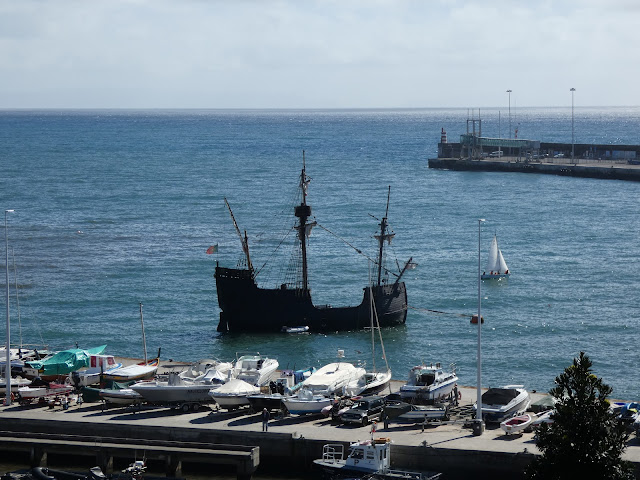 |
| The replica Santa Maria, used for whale watching. |
 |
| The cruise ships are in town, which heralds lots of 'Saga Louts' wondering about and time to take the car for a spin! |
The great British marine artist Thomas Whitcombe 1763 to circa 1824, painted scenes from Madiera, including the picture below of the Portuguese frigate, Real Fonsor 28-guns, seen approaching Funchal.
 |
| The Portuguese Navy's frigate 'Real Fonsor' shortening sail as she approaches Funchal, Madeira, with other vessels lying in the roadstead offshore. - Thomas Whitcombe dated 1812. |
The photos I took from a park above the harbour, of the modern day Portuguese navy corvette, António Enes, made for a great comparison to Whitcombe's classic rendition.
 |
| The António Enes are armed with 1 × twin 3 in (76 mm)/50 calibre Mk 33 guns, 1 × twin 40 mm (1.6 in)/L70 Bofors guns, Hedgehog ASW mortar, 2 × depth charge throwers. |
Everywhere you go in Funchal, there are reminders of its long history, with former coastal forts now converted into very nice restaurants, with gun embrasures incorporated into coastal views with added historical ambiance, to living history in the form of toboggan sledge rides in traditional basket sledges dating back to the 19th century when they were used as a means of transport by the locals wanting to travel quickly from the village of Monte, now a suburb of Funchal into the city.
The Monte Basket Cars travel two kilometres in ten minutes with passengers safely in the hands of two drivers (the so-called carreiros), who push and guide the basket car from the rear, using their boots as brakes. This means of transport dates back to 1850 and continues today as a tourist attraction.
 |
| Funicular railways have been replaced by cable cars, but the sledges still run. |
The ride was great fun, with the drivers turning the sledges side on to sharp corners, rally car style, with watchers along the route to control other vehicles who might otherwise inadvertently drive across in front of a sledge, not such a problem back in 1850.
Another great way to explore more widely in Funchal is to ride the two cable cars to the top of the town where as well as enjoying the views and using the sledges as part of the return journey, you can explore two marvellous gardens incorporating plants and trees, native to the island and from all parts of the globe.
In addition we grabbed a boat ride to see the whales that turned out to be dolphins, and not easily seen as there were too many folks on the boat, who all wanted to be on one side of it when the one Common Dolphin showed up, and so I contented myself with a nice day out on the briny together with the odd picture of a fin and a splash!
Of course as beautiful as Funchal is, we had the car so that we could explore the rest of the island determined to drive its circumference and include some specific venues along the way during our stay, plus to build in a few walks to further explore the interior.
 |
| The map illustrates our wider exploration of Madeira |
 |
| Bird of Paradise plants abound in the island and always catch the eye. |
 |
| Penha de Águia, or Eagle Rock seen from the Fortim do Faial |
 |
| Not exactly an Eagle, but a beautiful male Kestrel, Falco tinnunculus, on the hunt for lizards and small mammals. |
 |
| Whilst checking out the views, a constant "click click" call drew my attention and eventually I spotted this Blackcap, Sylvia atricapilla, being all shy among the bushes. |
 |
| The Madeiran wall lizard (Teira dugesii). Watch out for that Kestrel! |
 |
| Ponta do Pargo Lighthouse, opened in 1922. |
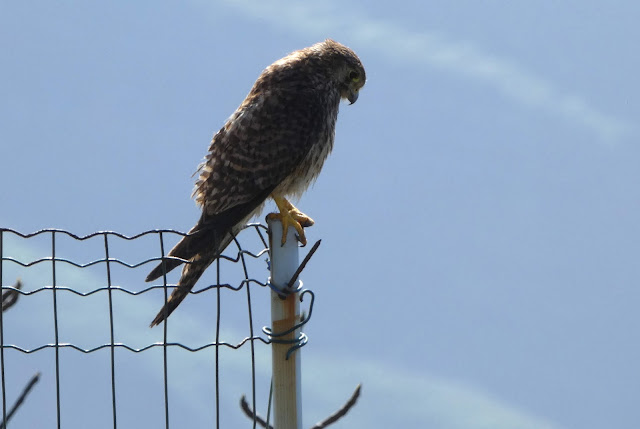 |
| We found lots of kestrels in Madeira, this one a female, happily enjoying the view from the lighthouse |
Santana, not the band from the 70's, but the village in Madeira, is short for Santa Anna (Saint Anne) is known for the traditional homes constructed with sloping triangular rooftops, and protected with straw.
These were mainly rural homes, used by local farmers, during the settlement of the island, with white-painted walls, red doors and windows with blue trim.
Most of the surviving buildings are tourist attractions, and maintained (for example, the straw roofs are replaced every four to five years).
 |
| I think the local authority will need to have a word about the unofficial colour scheme! |
 |
| The cables of the Achadas da Cruz cable-car leading down to the coastal path 2000 feet below. |
 |
| Ah yes, that perfect Zen moment! Living the dream. |
 |
| Atlantic Canary, Serinus canaria, hunting for bugs among the garden veg. These fork tailed little finches were quite common, singing away with a delightful warbling song. |
Our drive up to the town of Seixal and on to Porto Moniz follows the north coast road that cuts through the new tunnels created in the volcanic rock cliffs that plunge into the sea, with the occasional stretch offering a chance to park up and take in yet more massive Atlantic waves, with spectacular white foam crashing against the rocks.
 |
| The fork tail, sweet song and brown wing covers reveal yet another Atlantic Canary perched among the tree tops. |
Eira do Serrado to Curral das Freiras (Nuns Valley)
Parts of the path down are really steep and we were both glad to have brought our walking poles to take the pressure of the knees, constantly being locked to control the rapidity of the descent.
The second highest summit in Madeira can be reached by car and so we hired a private cab to drive us up some very tight roads so that we could both enjoy the stunning views, without me having to constantly scan the road ahead.
These high mountain areas are home to very specific fauna that has developed to survive in this challenging environment.
My attention was grabbed by a rapidly moving little bird that I would know at home as a pipit, such as the Meadow Pipit, and indeed I was right, when I got to check my bird book, but with this one a unique sub species endemic to Madeira and the Canary Islands, Berthelot's Pipit, Anthus berthelotii, a new sighting for me and an exciting spot.
 |
| Berthelot's Pipit, Anthus berthelotii maderensis, is the specific variety found in Madeira. |
As well as the radar installation, the summit is a good location for an observatory with unobstructed views of the night sky.
The beauty of time away from the normal routine is an opportunity to regroup and refocus and the odd evening after dinner gave me a chance to get my Kiss Me Hardy Ship Record Cards done for the Camperdown collection, along with some other reading and contemplations.
 |
| One job finished while I was away - my new KMH, Battle of Camperdown Ship Record Cards are finished. |
As well as that, I placed an order with Helion Books for one of their latest new titles, and it turned up soon after we got back home, and will give a clue as to what I intend to build next as part of the 1:700 ship collection.
Book review to follow.
 |
| My new reading. https://www.helion.co.uk/military-history-books/suffren-versus-hughes-war-in-the-indian-ocean-1781-1783.php?sid=77bbddf1910228f4d83db3447f2da916 |
As well as that, I have been further contemplating the use of Far Distant Ships (FDS) for future big-battle games and extending the collection into earlier periods to be able to fight some of the most notable historic engagements from the Seven Years War onwards and have been pondering the problem of decent maps illustrating battle set-ups, perfectly available for a battle like Trafalgar, but less so for actions such as the Battle of Minorca, 20th May 1756 or 'Byng's Action', a battle from my schoolboy history lessons complete with the drama of Admiral Byng being shot on his own quarterdeck at Portsmouth for failing to do his duty, otherwise known as "pour encourager les autres".
.jpg) |
| Battle of Minorca, 20th May 1756 or 'Byng's Action' as set up in Flying Colours from GMT and ripe for conversion to Far Distant Ships in 1:700 |
Then I discovered that the GMT board game 'Flying Colours works on the same time and sea scale as FDS, which should make converting their setups for a tabletop rendition very dooable - more anon.
Finally, in my delving's into naval activities around Madeira, I came across a minor action that I was unfamiliar with but has sparked some ideas for another scenario, described on Wikipedia as the 'Action of 24th February 1780'
 |
| Plan of the movements made by the French ship Prothée to protect its convoy while it is attacked by several English ships off Madeira on 24 February 1780. https://en.wikipedia.org/w/index.php?title=Action_of_24_February_1780&oldid=1186916988 |
This skirmish developed as Admiral George Rodney, flush with the success of his nighttime victory at the Battle of Cape St. Vincent or the 'Moonlight Battle' the previous month, and his subsequent relief of Gibraltar was leading the fleet back to the Caribbean when, as Clowes describes it below, from volume Three of his History of the Royal Navy:
'On this return voyage it (Rodney's Fleet) fell in with fifteen French supply vessels, convoyed by two sixtv-fours, bound for the Ile de France, in the Indian Ocean. One of the ships of war, the Protée, and three of the storeships were taken. Though trivial, the incident illustrates the effect of operations in Europe upon war in India.'
The French naval accounts seem to make more of the action than the rather dismissive four lines from Clowes, complete with an illustration seen above, so might make for an interesting tabletop recreation.
Anyway, enough of all this holidaying and contemplative rumination, back to the painting desk.
More anon
JJ

















.jpg)




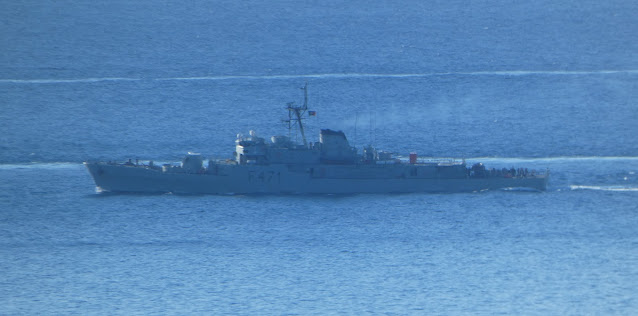































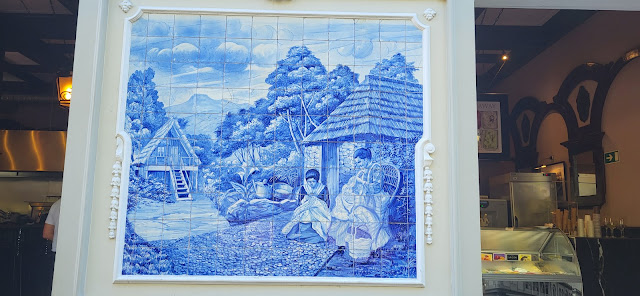









































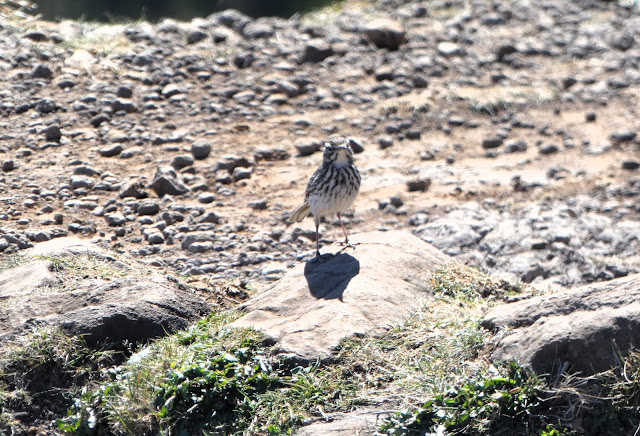





JJ, your travelogues are absolutely without equal. Enjoyed your recollections of Madeira very much. Thank you!
ReplyDeleteHi Jon,
DeleteThank you that's very kind, and it's always great to get a message like yours as the pleasure of enjoying these experiences is only made better when you can share them with others.
All the best
JJ
That was a delightful post to read, so much so that I mentioned it to an old friend married to an American/Portuguese wife, to be clear just the one woman not two.
ReplyDeleteHe reminded me that they had indeed visited the island themselves being equally so much taken by the flora and fauna that they had returned the following year just before the pandemic. A case perhaps redolent of the old music hall song: "Have some more Madeira my dear".
Thank you and yes indeed "Please pass the Madeira".
DeleteI know that both Carolyn and I are keen to return as we made some friends when we were there who it would be fun to meet up with again and nine days only allows one to scratch the surface of the place, but what we found was so lovely that we want to go back.
Really glad you enjoyed the read.
JJ
That was a great read! In my ignorance I never knew about this amazing location or it's history. Certainly a place to put on my "need to visit" list for the future.
ReplyDeleteHey thank you and Madeira is indeed a very special place for those of us who enjoy sun, sea and food combined with lovely people, great history and stunning scenery, and I know Carolyn and I are looking forward to going again. Cheers JJ
DeleteNice article.
ReplyDelete